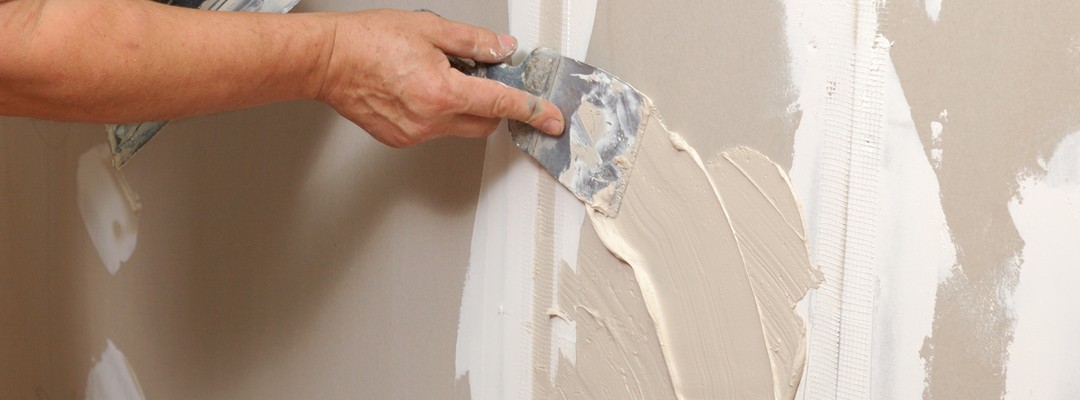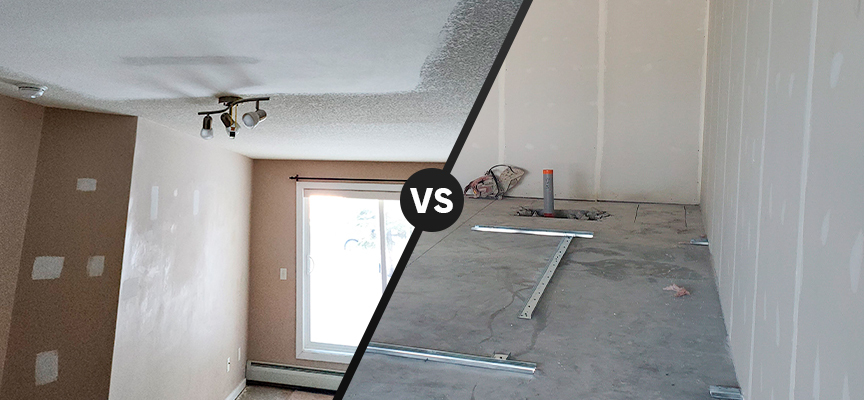Step-by-Step Approaches to Getting Flawless Drywall Repair Service and Setup
Achieving perfect drywall fixing and installment requires a methodical strategy. It involves understanding the various types of drywall and the tools necessary for the job. Proper location preparation is essential prior to beginning any job. Drywall Repair Ogden UT. Each step, from patching openings to mounting new sheets, demands attention to detail. The process does not finish with installation; ending up techniques are important for a refined appearance. The next steps will guarantee a smooth result, however what precisely do they require?
Understanding Drywall Types and Tools Needed

The installation devices are similarly vital. An utility blade is essential for reducing drywall sheets, while a drywall saw can help in making specific cuts for outlets or fixtures. T-squares ensure precise dimensions, and drywall screws or nails safeguard the panels to wall studs. Furthermore, a drywall lift can promote the installment of large sheets, decreasing physical pressure. Experience with these tools and kinds appreciably adds to the efficiency and high quality of drywall projects.
Preparing the Area for Repair or Installation
Preparing the location for drywall repair service or installation is crucial to assure a effective and smooth process. The surrounding space ought to be cleared of furniture and various other barriers to supply ample functioning area. This not only guarantees security yet also prevents damages to valuables. Next off, it is essential to cover the floor with decrease fabrics to capture any debris or dust produced throughout the work.
In addition, the walls ought to be inspected for any kind of loosened paint or wallpaper that might interfere with adhesion. Getting rid of these elements develops a tidy surface area for the new drywall. Before beginning, it is suggested to shut off power to electric outlets or fixtures around. Ensuring ample lights in the office will certainly further improve presence and emphasis throughout the repair service or setup process. Interior Painting. By diligently preparing the location, one lays the groundwork for an effective drywall task
Step-by-Step Process for Patching Holes

Covering openings in drywall needs a methodical approach to ensure a smooth repair. The very first step involves examining the size of the hole. For tiny openings, a patching substance might be sufficient, while larger openings require a spot. Next, the damaged location should be cleaned and prepared by getting rid of any type of loose particles.
For small holes, using spackling compound with a putty knife is recommended, smoothing it over the hole and feathering the sides. When dry, fining sand the location assures a smooth finish. For larger openings, a drywall spot must be reduced to dimension, placed over the opening, and protected with screws. After setting up the patch, the very same spackling process is duplicated, adhered to by sanding.
Finally, the patched area has to be primed and repainted to match the surrounding wall. This meticulous procedure ensures an expert look and prolongs the lifespan of the repair.
Installing New Drywall Sheets: A Comprehensive Overview
Mounting new drywall sheets calls for mindful planning and implementation to ensure a aesthetically attractive and strong surface. First, the location needs to be measured properly to determine the number of sheets required. It is essential to select the best density, normally 1/2-inch for indoor wall surfaces and 5/8-inch for ceilings or fire-rated applications.
Next off, the studs or structure ought to be inspected for any kind of abnormalities, ensuring they are lined up and appropriately spaced. When putting the drywall sheets, they ought to be positioned flat to reduce seams and enhance structural stability. A drywall lift can be helpful for overhead setups.
Attaching the sheets with drywall screws at suitable intervals makes particular a protected setup. It's essential to countersink the screws somewhat below the surface area to plan for the finishing process. Complying with these standards will lead to a solid foundation, ready for the next steps in drywall ending up.
Ending Up Touches: Taping, Mudding, and Sanding Techniques
As soon as the drywall sheets are securely fastened, the emphasis moves to the finishing touches that will provide a polished appearance. This procedure begins with taping, using either paper or fiberglass fit together tape to cover the joints between sheets. The tape guarantees a smooth shift, decreasing the threat of fracturing. Adhering to insulation, mudding is crucial; a joint substance is get more info used over the tape to fill up gaps and create a smooth surface. Commonly, several layers are needed, every one feathery out further than the previous to lessen presence.
After adequate drying time, fining sand is the last step in accomplishing a perfect surface. A fine-grit sandpaper is made use of to smooth the dried out compound, guaranteeing there are no imperfections or bumps. Focus to detail during this stage is significant, as it substantially influences the overall look of the wall surface. Completion result need to be an even, professional-looking surface prepared for priming and painting.
Often Asked Inquiries
How Do I Select the Right Drywall Density for My Task?
To select the ideal drywall density, consider the job's function, location, and structural demands. Criterion densities include 1/2-inch for general usage and 5/8-inch for fire-rated applications, making sure sturdiness and conformity with building regulations.

Can I Set Up Drywall Over Existing Drywall?
Yes, installing drywall over existing drywall is possible. Nevertheless, it is vital to ensure the underlying surface is complimentary and safe from damage. Correct fastening and consideration of density are important for a successful installment.
What Are the very best Practices for Drywall Disposal?
The ideal practices for drywall disposal include reusing when possible, utilizing neighborhood waste management services, and following standards for dangerous products if appropriate. drywall contractors. Correctly identifying and securing waste warranties compliance and safety and security during disposal
Just how Long Should I Await Mud to Dry Prior To Fining sand?
Usually, one need to wait 24 hr for drywall mud to completely dry prior to sanding. Drying time can differ based on moisture and temperature level, so inspecting for a firm texture is recommended prior to proceeding.
Exist Eco-Friendly Drywall Options Available?
Yes, green drywall options are available. These options commonly use recycled materials, low-VOC adhesives, and sustainable production techniques, decreasing ecological effect while offering reliable insulation and longevity for numerous building and renovation jobs.
An utility knife is crucial for cutting drywall sheets, while a drywall saw can assist in making accurate cuts for components or electrical outlets. Preparing the location for drywall fixing or installation is crucial to assure a smooth and effective procedure. Patching holes in drywall needs a systematic approach to guarantee a smooth repair. Setting up brand-new drywall sheets calls for careful planning and implementation to assure a sturdy and aesthetically appealing finish. Yes, mounting drywall over existing drywall is possible.